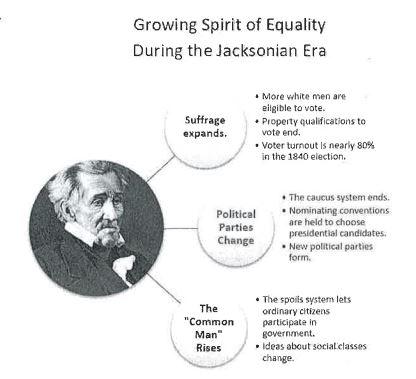
Topic 7.2-7.5 Summative assessment
Quiz by Leesa Halcro
Feel free to use or edit a copy
includes Teacher and Student dashboards
Measure skillsfrom any curriculum
Measure skills
from any curriculum
Tag the questions with any skills you have. Your dashboard will track each student's mastery of each skill.
With a free account, teachers can
- edit the questions
- save a copy for later
- start a class game
- automatically assign follow-up activities based on students’ scores
- assign as homework
- share a link with colleagues
- print as a bubble sheet
26 questions
Show answers
- Q1After Jackson's presidency in 1828, why did his supporters call him "The People's President"?Government officials were replaced with those who could do the job better.He invited his political opponents to his reception at the White HouseMore people were involved in the voting processJackson put an end to the spoils system.30s
- Q2Which of the following did President Andrew Jackson think favored the wealthy?the national debtthe right to voteThe Indian Removal Actthe National Bank30s
- Q3In the 1820s, Democratic-Republicans split from National Republicans because theywanted to keep the federal government small.supported a national government with a limited role.supported states’ rights.All of the above30s
- Q4How did high tariffs place the Southern states at a disadvantage compared to the Northern states?The South lost economic power from protesting the tariffs and they wanted federal support.The South had more manufacturing and more trade with Europe than the North.The South sent more manufactured items to the North, who had to pay taxes on them.The North had more manufacturing, but the South had more taxable trade with Europe.30s
- Q5When Jackson was president, how did more people participate in the political process?Bureaucrats were fired and replaced with Jackson’s supporters.Southerners gained a louder voice in objecting to high tariffs.Democrats used nominating conventions, rather than caucuses, to choose candidates.Southern states began nullifying, or refusing to obey, some federal laws.30s
- Q6President Van Buren responded to the depression following the Panic of 1837 by creatinga much lower tariff.an independent federal treasury.a new cabinet position.a new national bank.30s
- Q7Which president served for the shortest period?Ben FranklinAbrham LincolnWilliam Henry HarrisonJohn Tyler30s
- Q8The U.S. government established Indian Territory in present-day Oklahoma becausethe Five Civilized Tribes expressed interest in the region.the fertile land would support farms owned by native peoples.few white settlers wanted to move to the area.some members of the Five Civilized Tribes already lived in the region.30s
- Q9Based on map, which statement best describes the consequences of the Indian Removal Act?Due to forced removal, most Native American groups eventually moved west of the Mississippi River.The Sioux led other native American groups in a war of resistanceNative Americans voluntarily left thier homes to move east of the Mississippi.President Jackson ordered U.S. troops to protect Native American lands in Georgia30s
- Q10In Worcester v. Georgia (1832), the Supreme Court ruled that the Cherokeeremoval was legal only if the government provided food for the long journey.were not citizens and therefore no treaties with them were binding.are a separate nation and not subject to the laws of Georgia.could be moved only if they were paid fairly for their land.30s
- Q11What was President Jackson’s response to the Supreme Court ruling in Worcester v. Georgia?He supported the ruling but allowed settlers to push the Cherokee people off their own landHe supported the ruling and immediately forced the Cherokee people to relocate.He disagreed with the ruling and approved a treaty to relocate the Cherokee.He disagreed with the ruling and made a compromise treaty with all Cherokee leaders.30s
- Q12In 1838, President Van Buren ordered the U.S. Army toforcibly remove over 15,000 Cherokee people from thier landseize all weapons from native peoples in Georgia.move the Choctaw but allow the Cherokee to remain in Georgia.pay Native Americans to relocate in the West.30s
- Q13Which best describes how the Seminole responded to the Indian Removal Act of 1830?They agreed to sell their land and move to Indian Territory.They joined with Black Seminoles to attack white settlements in Florida.They turned to the U.S. Supreme Court to defend their claims to their land.They lost their land and were forced to travel on the Trail of Tears.30s
- Q14“[T]he only means of preserving the Indians from that utter extinction which threatens them, is to remove them from the sphere of this [white settlers’] influence . . . no change has occurred, or probably can occur . . . by which the progress of their declension [decrease] can be arrested [stopped], so long as they occupy their present situation.”—Lewis Cass, from “Removal of the Indians,” The North American Review, 1830 What is Cass suggesting in this passage?that Native Americans should be removed from their landsthat some land where Native Americans currently reside should be set aside for themthat further white settlement into native lands should be haltedthat the U.S. government should honor its treaties with Native Americans30s
- Q15“[T]he only means of preserving the Indians from that utter extinction which threatens them, is to remove them from the sphere of this [white settlers’] influence . . . no change has occurred, or probably can occur . . . by which the progress of their declension [decrease] can be arrested [stopped], so long as they occupy their present situation.”—Lewis Cass, from “Removal of the Indians,” The North American Review, 1830 What reason does Cass give for his proposal?He thinks white settlers are more entitled to the land than native peoples.He believes this is the only way for the Native American population to survive.He wants to preserve the natural resources on native land.He hopes Native Americans and white settlers can both occupy the land.30s
